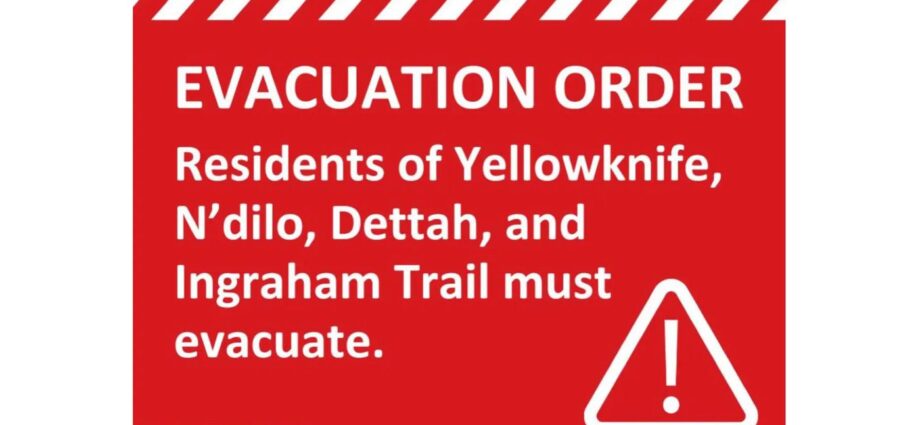
By Kinnukana, Local Journalism Initiative Reporter, Alberta Native News
August 20, 2023
(ANNews) – Residents of the Northwest Territories (NWT) have been fleeing wildfires surrounding their communities and finding refuge in Alberta this summer. The NWT is on fire, and over the hottest summer ever, residents of several communities have had to leave their homes in a state of emergency.
There are 45,668 people living across the Northwest Territories (2023 Statistics Canada) and more than half of them have been evacuated out. The NWT encompasses Treaty 8 and 11 and also has comprehensive land claim agreements with the Inuvialuit, Gwich’in, Sahtu, and Tłı̨chǫ people of the North. Of the total population in the NWT, approximately 50% are Indigenous and many live and work in Yellowknife.
Most recently, Yellowknife, both the capital and only city in the NWT, and the First Nation communities of N’Dilo and Dettah, which lie on the outskirts of the city, are under an evacuation order. Together, they encompass approximately 20,000 residents, nearly half of all the people in the NWT. Everyone was ordered to leave by noon on Friday, August 18, 2023, as winds are expected to shift eastward and direct fires toward the city over the weekend.
There is only one highway out of Yellowknife, Highway 1. Residents who have vehicles are being encouraged to drive out of the community and carpool where possible. The drive out comes with many challenges, not withstanding the continuous smoke that fills the air resulting in poor air quality and low visibility. The highway has sections of fire alongside the road from an earlier fire that caused an evacuation of the Tłı̨chǫ community of Behchokǫ̀. Greg Nasogaluak, an evacuee who travelled from Yellowknife to Edmonton said, “It was a longer drive than normal due to wait times for gas. It took patience. Everyone needed to have patience on the drive down. We expected it but it was still not good because you see people travelling with full vehicles, including children, Elders, persons with special needs and pets. It had to be tough for them.”
The distances between communities in the North, including Northern Alberta, are vast and services are limited. There are very few places to stop for gas along the way. Residents are stopping at the Big River Gas Station in Fort Providence and traffic is backing up. It normally takes three hours to drive to Fort Providence from Yellowknife but with the many vehicles on the road, it is taking up to eight hours for the first leg of this trip.
As evacuees drive south, they are passing by the community of Enterprise where they are reminded of what may happen in their hometown too. Earlier, Enterprise was evacuated and nearly 80% of the community was burned down and its members are now displaced.
Yellowknife evacuees are being asked to find their own accommodations where possible. Those in need of support and accommodations can go to a number of evacuation centres in Alberta, such as Valley View, Fox Creek, St Albert, Leduc, Red Deer and Calgary. Many gracious Albertans have also offered up their homes and land for evacuees to camp at. The Government of the Northwest Territories is also providing evacuation flights for anyone who has mobility or health conditions. In order to support evacuees, the GNWT is asking residents to fill out an Evacuee Registration Formavailable at gov.nt.ca.
Many residents are focused on getting their families out safely and left with only their sentimental items, but they also worry about leaving their homes behind. It is especially hard for Indigenous people to leave as their identity is rooted in the land. Indigenous people believe that we must take care of the land as it takes care of us by providing food and water. The land also helps Indigenous people to reconnect with lost culture and provides healing from past traumas. These fires will have lasting affects on the land and wildlife for many years, and it will no doubt change the cultural traditions of the past.
Fire crews have been working tirelessly to create firebreaks around the City to clear strips of land and trees and anything else that could fuel the fires. Canadian Armed Forces members are in the NWT helping with firefighting and evacuation efforts. Air Tankers and sprinkler systems are being used to wet the ground as much as possible and are running 24 hours a day. The Yellowknife RCMP have deployed additional police officers who will be conducting neighbourhood patrols and providing evacuation assistance for as long as it is safe to do so.
Subscribe to our newsletter.
The latest information on community statuses, notices and alerts can be found at the following link gov.nt.ca for latest community statuses.

